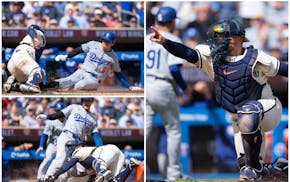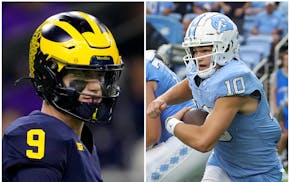Pat Petschel carefully laid out uniforms for his second grade Highland Ball baseball team after the first practice. His main concern was that every kid had a jersey that fit and that everyone went home with all the uniform accessories.
The first-year coach felt like a wounded animal surrounded by a pack of hyenas.
"They're like, 'I want 7. No, I want 7. No, I'm going to get 7,' " Petschel recalls.
No. 7. Joe Mauer's number. Petschel's little hyenas fought over that jersey eight years ago.
"There was like an all-out brawl to get No. 7," says Sam Petschel, the coach's son. "A lot of pushing and shoving and arguing."
Sports numbers worn by our childhood heroes have that effect. Their uniform numbers become our numbers — if we're lucky enough to grab it first or win a rock-paper-scissors tiebreaker.
The numbers of two of Minnesota's favorites will receive the highest honor on consecutive weekends. The Lynx will retire Lindsay Whalen's No. 13 on Saturday; the Twins are retiring Mauer's No. 7 one week later, June 15.
Think about how many young adults throughout Minnesota wore either No. 13 or No. 7 on their youth teams.
"No. 13 was the golden number," says 23-year-old St. Peter native Calleigh Carlson, who wore Whalen's number as a kid.
"No. 7 was the number to be," says Sam Petschel, now a freshman at St. Thomas Academy.
Anyone who played sports at any level likely has their own golden number. As a kid growing up in the heart of Atlanta Braves territory in the late 1970s and early 1980s, my guy was Dale Murphy, No. 3. Every kid wanted to be Murph in backyard whiffle ball games.
In basketball, I wanted No. 32, the Magic man. I've dreamed of being able to wear No. 32 and deliver no-look passes like Magic Johnson.
A generation of kids globally argued over who got to wear No. 23 on their basketball teams. No ID required for that one. Some numbers are synonymous with the athletes who made them famous.
Do you remember yours? Was it 34 (Puck), 21 (KG) or 28 (AP)? Did you beg to wear No. 14 because that was Hrbek's number?
Hrbek picked a different number as a kid. In his first summer of organized baseball, his T-ball team issued all-white jerseys. Hrbek asked his mom to sew No. 6 on the back in honor of his idol, Tony Oliva.
A new wave of Minnesota kids felt the same attachment to 13 and 7, a pair of iconic numbers of two athletes raised right here.
Neither Whalen nor Mauer chose their number out of reverence for a sports hero. The numbers were assigned to them.
In Whalen's case, No. 13 was the smallest varsity basketball jersey at Hutchinson High School and she was the youngest player on the team, so she picked last. She stuck with it.
Mauer wore No. 16 in high school but was assigned No. 7 at his first minor league stop after being drafted by the Twins. He wore different numbers as he progressed through the farm system. He hoped to return to No. 16 when he reached the majors, but that number was already claimed by Doug Mientkiewicz. So he went back to No. 7.
Andy Rostberg coached Whalen at Hutchinson and was there the night the school retired her number. Rostberg doesn't recall anyone wearing No. 13 in that interim.
"I think they were too scared to wear it," he says.
Rostberg's niece, the aforementioned Calleigh Carlson, wore Whalen's number for several years in travel basketball. Carlson met Whalen through family connections and built a shrine to her favorite player in her bedroom. Carlson's wall was covered in photos and newspaper clippings chronicling Whalen's career.
"She's a huge role model for me," Carlson says, joking that she would get jealous when someone else took No. 13 on her teams.
Carlson played basketball and tennis in high school. She continued her tennis career at Gustavus Adolphus College. She's now a young professional in the Twin Cities.
She still remembers a story her grandfather, former Hutchinson football coach Grady Rostberg, often told her about the countless hours Whalen spent in the driveway shooting baskets, even in inclement weather.
"That story and the dedication and passion she had for her craft really translated to all different aspects of my life," Carlson said. "If you want to be good at something, you have to put in the effort and the hours and the time. She was a great example for me growing up."
Petschel felt that same way about Mauer as a kid growing up in Mauer's hometown of St. Paul. He had jerseys, posters and a Mauer decal in his bedroom.
He even once wrote Mauer a letter, telling him that he loves baseball and also wears No. 7. Imagine his excitement when he came home one day and found a response letter from Mauer.
"I think we were screaming so much that the neighbors might have been worried," Sam says.
Petschel wore No. 7 for three or four Little League seasons. It was an inside job. His dad made a savvy decision after that first summer.
"My son made me hand him No. 7 before I handed out any other jerseys," Pat says.
Lesson for parents: It pays to coach.
A number being retired signals finality, a symbol never to be worn again in that organization. Nos. 13 and 7 will receive that ultimate honor one week apart, just across the street from each other.
As a spotlight shines on those uniforms in celebration of Lindsay Whalen and Joe Mauer, a legion of fans will pause and smile, knowing they once wore those numbers, too.
Chip Scoggins • chip.scoggins@startribune.com

Scoggins: Finch feeling heat of the Suns as playoff battle looms
Scoggins: Why 'championship or bust' fits these Wolves

Scoggins: Anatomy of a game-saving play as Correa throws out Ohtani


